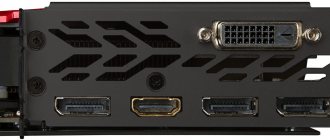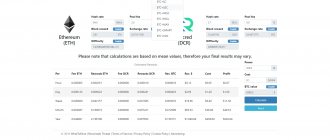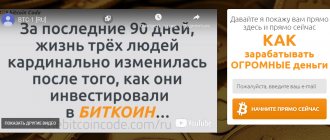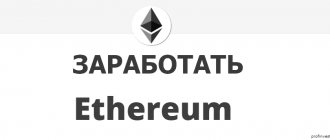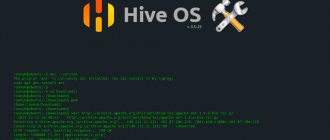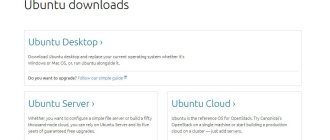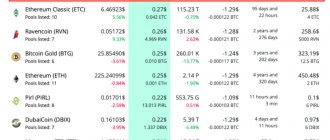How to reduce reserved VRAM Windows 10
There is a workaround to deal with the strong DAG file.
If you enable the iGPU (the internal gpu in your processor) and use hdmi on the motherboard, then Windows will not allocate that memory from your 4GB video cards.
If you don't have internal graphics on your processor, the workaround will work if you install a graphics card with more than 4GB of memory as your main graphics card (or a secondary card that you only use as a stub, for Windows rendering, not for mining).
Insert HDMI into the motherboard, not the video card
How to mine coins on Ethash?
There are several types of mining, each of which has its own advantages and disadvantages.
| View | What's the point | Minuses | pros |
| Solo mining | The miner buys the equipment and installs it at home. Works alone, without connecting to the pool. | All the disadvantages are associated with finding mining equipment at home:
| All profits go to the miner. |
| Solo mining via pool | The miner works alone through a pool. | Everything is the same plus payment of commission to the pool. | The computing power of the pool participants is summed up, due to which you can earn more. |
| Regular mining via pool | The miner connects to the pool and receives a share of the pool's total profits. | All the same. | There are different schemes for distributing profits between pool participants, in most cases it is more profitable than any type of solo mining. |
| Cloud mining | The miner rents computing power from the data center and can use it for mining solo or through a pool. | Favorable rental prices start with contracts of 1 year or more. | No need:
|
In most cases, it is more profitable to work through a pool, teaming up with other miners.
Cloud mining
There are 2 large and proven mining centers where you can buy power:
- Hashflare.io.
- Genesis-mining.ru.
Ethash mining rates are shown in the screenshots below.
Price on Hashflare.io.
Price on Genesis-mining.ru.
Recently, tariff plans are often out of stock on Genesis-mining.ru, which may be due to the restructuring of the Ethereum network to PoS.
Mining via pool
For beginners who do not know how to start mining, it is best to proceed in the following sequence:
- Decide on equipment and miner programs.
- Select a pool.
- Go to the pool, download the miner. The necessary settings of the body file will already be specified in it; you just need to create a worker and start the work.
Downloading programs from unverified sources or working through small and little-known pools is not recommended.
You can watch this good video on how to mine cryptocurrencies on Ethash. The blogger understands the settings of mining through a pool using the example of Pirl (PIRL).
Equipment and programs for mining
GPUs are the best for mining coins on Ethash. You can use the CPU, but it doesn't make a profit.
Claymore's Dual Miner is used as a miner program. It is suitable for Nvidea, AMD video cards. In addition to the main algorithm, Ethash allows you to work with Blake256 or another cryptographic algorithm. It is best to download the program from the pool through which mining is planned.
You can learn about setting up the program from this video.
On choosing a video card for mining, you can see this review, where a blogger tests Ethash mining on the Radeon 560 and shares his thoughts on the topic.
The second option is to specify the epochs manually
To manage the DAG file and its epochs in programs, there are the following commands:
-eres — set the number of DAG epochs for which the program will reserve a buffer.
Values: 0 - if video cards have little video memory (4 GB);
1; 2 (default)
Example: PhoenixMiner.exe -pool pool_address -wal wallet -worker worker_name -eres 0
-lidag (value) - slow down DAG generation to avoid crashes when switching DAG epochs (0-3, default: 0 - fast, 3 - slow).
Can be specified for individual cards. Currently the option only works on AMD cards
Example: PhoenixMiner.exe -pool pool_address -wal wallet -worker worker_name -lidag 3
-gser - initialize DAG creation on several video cards (0 - No initialization, all video cards generate DAG at the same time (default);
1-part overlap of DAG generation on each card;
2 - no overlap (each card waits for the previous one to finish generating the DAG);
3-10 - from 1 to 8 seconds of delay after each DAG building before the next one)
-rvram — set the minimum reserved VRAM, which cannot be used for mining. The default values are 384 MB on Windows and 128 MB on Linux.
You can also set -rvram -1 if you want to disable protection against using too much VRAM.
PhoenixMiner.exe -pool pool_address -wal wallet -worker worker_name -rvram -1
How does Ethash work?
If a miner has penetrated a computer without the user’s knowledge, and the system has direct access to the Internet, its work begins. In this case, the Ethash folder is immediately created (in Windows 7, for example). When selecting combinations, if appropriate measures are not taken, the folder will increase in size over time.
Actually, the Ethereum miner itself is a very “gluttonous” thing. First of all, there is an incredible load on the RAM and computing capabilities of the central processor. This is understandable: within a certain time, he must calculate the required hash, which is akin to finding the required value from the combinations of a random number generator.
The fourth option is to mine other coins
Not a single ETH or ETC is alive in mining. And although Ethereum and Ethereum Classic are the best there is, it is better to look for other altcoins than the farms will put up.
READ:
- — 1.13 GB
- — 1.24 GB
- — 1.41 GB
- — 1.42 GB
- — 1.45 GB
- — 1.57 GB
- — 1.68 GB
- — 1.75 GB
- Mix Blockchain – 1.85 GB
- — 2.02 GB
- - 2.1 GB
- - 2.59 GB
It is important to immediately sell these coins because, unlike ETH, they can be sold off at any time!
Miner uninstallation process
Finally, let's look at the issues of deleting the main application. It's not that simple. The fact is that it can be impossible to detect (often it is not in the list of processes or running programs and services; it can masquerade as the svchost system process, etc.).
You can, of course, try to use the programs and components section, find the original application there with the name of the miner and remove it using a standard tool. You can go further by using uninstallers like iObit Uninstaller to uninstall. But such methods are applicable only if the main program is present in the list of installed applications. But, unfortunately, she is usually not there.
So what should we do? As practice shows, today the optimal solution for cleaning the system from this scourge is to use the popular anti-virus utility Dr. Web CureIt!, which, unlike most other scanners, detects a threat and neutralizes it. And only after the main applet is neutralized, the Ethash directory in the location indicated above can be deleted without any consequences for the system (in the sense that it will not be created again).
Sometimes you can do without it. It is enough in the “Task Manager”, with all applications closed, to track all the processes that overload system resources in idle (inaction) mode, determine the location of the files responsible for the processes and delete them yourself. Again, after deleting the main initiator object, you can safely get rid of the described directory. And don't forget to clean your registry!
What is the DAG file for?
A DAG is a specific block of data that is used when searching for blockchain elements on the network. It is built on the Dagger Hashimoto algorithm. The mined currency is Ethereum. But there are other coins in this algorithm. For example, Whale, Ubiq, Pegas, Dubaicoin, Musicoin, Soil and others. When the user starts the miner itself, the DAG must be loaded into memory. Its more accurate size is 1200 MB. Over time, it is able to increase in size. This phenomenon is called the change of eras.
Each change of such epochs has its own file size. You can find out the amount of memory occupied by a DAG file at: https://investoon.com/tools/dag_size. Here you can find out the file size for all coins on the Ethash algorithm. Each era changes approximately once every 10 days.
Problems with the DAG file first appeared in the winter of 2020. After changing several dozen eras, the size increased to 1.7 GB. Using this algorithm on video cards with 2 GB of video memory has become impossible. But in some situations the problem could still be solved.
Controversy – What to mine
Until recently, the Ethash algorithm and the cryptocurrency based on it were considered impenetrable for ASICs. The electricity required for calculations was several times higher than the payload - and ETH continued to be mined with traditional video cards.
Nvidia added fuel to the fire by releasing its video card models specifically for mining, the P-106 (analogous to the GTX 1060), which differed from their counterparts solely in the lack of ports for monitor output, a warranty period for service, but also cost 30% less than the Gtx 1050 Ti.
But with the recent update to the Bitmain line for Ethash, the situation has changed radically. And today you can mine ETH using a miner even if the price of ETH falls below $80. And do this with no less profit than using Bitmain solutions for BTC.
ASIC miners have been developed for mining Ethereum (ETH) using the Ethash algorithm
The launch of the first batch of ASICs for Ethereum (ETH) mining is being prepared. It is known that Vitalik Buterin’s cryptocurrency is based on Ethash, a well-known Proof-of-Work (PoW) algorithm that is used by many other coins.
This algorithm uses two standard cryptographic algorithms SHA-3 and Keccak. On the one hand, this provides resistance to mining using ASIC, on the other hand, it allows you to reduce verification and execution time.
ASIC resistance is guaranteed by an algorithm using a pseudo-random dataset initialized according to a variable blockchain. This dataset is called a DAG (directed acyclic graph) and is updated every 30 thousand blocks (about 5 days). Despite this, several companies have managed to use ASICs to mine ETH.
Linzhi is a Shenzhen-based company founded in 2020 by former Canaan Creative (Avalon Bitcoin miner) employee Chen Min. The startup, which has received $4 million in funding, is already working on this solution, albeit about 9 months behind schedule.
Initially, the first samples were supposed to appear in April 2019, and launch into mass production in June.
“We underestimated the complexity of the chip and the time required to develop the team and ensure the functionality of the company.
We hope that in the future we will be able to move according to the following schedule: experimental samples of devices will appear in December 2019, and in February 2020 we will launch them into mass production.”
The company is now preparing the first batch of 200 ASICs.
If ASICs prove competitive, then once mass production begins, the company will challenge industry leaders Bitmain and InnoSilicon. The first specifications mention 1400 megabytes per second (MG/s) with a flow rate of 1 kWh.
In comparison, the InnoSilicon A10 has a spec of 450 MHz/s with a power consumption of 850 W, while the NVIDIA GTX TitanV graphics card, one of the most powerful graphics cards on the market, reaches only 656 MHz/s with a power consumption of about 2.1 kWh (source f2pool).
Prices for ASICs are not yet known, but Chen has developed a system of discounts on first orders for buyers who purchase just a few devices, as they promote decentralization.
One of the main problems for the company that produces ASICs for Ethereum is the ProgPoW algorithm. It is a Proof-of-Work (PoW) consensus algorithm that is resistant to ASIC mining. Its development is already underway, but without any specific deadlines.
Of course, it is unlikely to be ready for the next Ethereum Istanbul hard fork, scheduled for October 2020. The update will be divided into two parts: the first part, if there are no delays, will be implemented in the network in October and will include six changes to the protocol (EIP).
In addition, Ethereum is preparing to switch to the Proof-of-Stake algorithm, which will happen simultaneously with the launch of Casper. The transition to PoS will make any ASIC completely useless.
As the Ethereum Foundation's plans progress, the company will focus on ETC mining.
Publication date 09/13/2019 Share this material on social networks and leave your opinion in the comments below.
5 / 5 ( 1 voice )
The latest news on the cryptocurrency market and mining:
Cloud mining of Bitcoin in 2020 - how to choose a reliable and profitable service?
Kraken Report: Bitcoin on the verge of “great adoption”, BTC price will rise by 50-200%
Bitcoin enters mega bull phase with over 93% of BTC addresses showing profits
Anatoly Aksakov commented on the adopted law on cryptocurrency in Russia
Platform for centralized management of the cryptocurrency mining process CoinFly
The following two tabs change content below.
- Author of the material
- Latest news from the world of cryptocurrencies
Mining-Cryptocurrency.ru
The material was prepared by the editors of the website “Mining Cryptocurrency”, consisting of: Editor-in-Chief - Anton Sizov, Journalists - Igor Losev, Vitaly Voronov, Dmitry Markov, Elena Karpina. We provide the most up-to-date information about the cryptocurrency market, mining and blockchain technology.
News Mining-Cryptocurrency.ru (go to all news feed)
- Cloud mining of Bitcoin in 2020 - how to choose a reliable and profitable service? — 08/14/2020
- Kraken Report: Bitcoin is on the verge of “great adoption”, BTC price will rise by 50-200% - 08/14/2020
- Bitcoin Enters Mega Bullish Phase, Over 93% of BTC Addresses Show Profit - 08/14/2020
- Anatoly Aksakov commented on the adopted law on cryptocurrency in Russia - 08/14/2020
- Platform for centralized management of the cryptocurrency mining process CoinFly - 08/14/2020
EthereumMining
